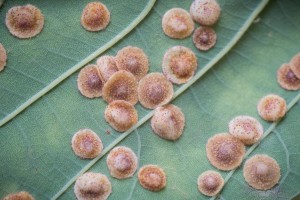If you’ve spent any time admiring the variety of oaks (Quercus spp.) on campus, you may have noticed strange growths on various parts of the trees. During last week’s Vegetation Survey and Assessment session, I came across a badly affected Mirbeck’s oak (Q. canariensis Willd., Fagaceae) tree – this time with distinct, small and rather neat-looking outgrowths… spangle galls!
There are typically four species of spangle gall wasps (Neuroterus spp.). On this particular leaf (right), we are fortunate enough to see two of those species in action…
Perpetrator 1:
N. numismalis: causes the silk-button gall, a thick disc with a deep central pit covered in golden-coloured parallel hairs radiating from the centre. Particularly around the leaf apex, these can be very numerous – with more than a thousand galls per leaf!
Perpetrator 2:
N. quercusbaccarum: causes the common spangle gall. This is similar, but more of a flat disc with a raised central mound. There is no rim, and minute red- and orange-brown hairs cover the whole surface.
For both wasp species, the larva matures in the gall throughout the winter (in abscised leaves) and emerge the following year between February and April. Larvae in galls that do not fall to the ground dry up and die, so the process of overwintering and emerging from fallen leaves is an integral part of the life-cycle. The adult wasps range between 1.4-2.4 mm in length, so it not surprising that the galls are more likely to be seen than the adults themselves!
It’s so easy to discover an entire microcosm growing right before your eyes… but remember, all that glitters is not gold!



